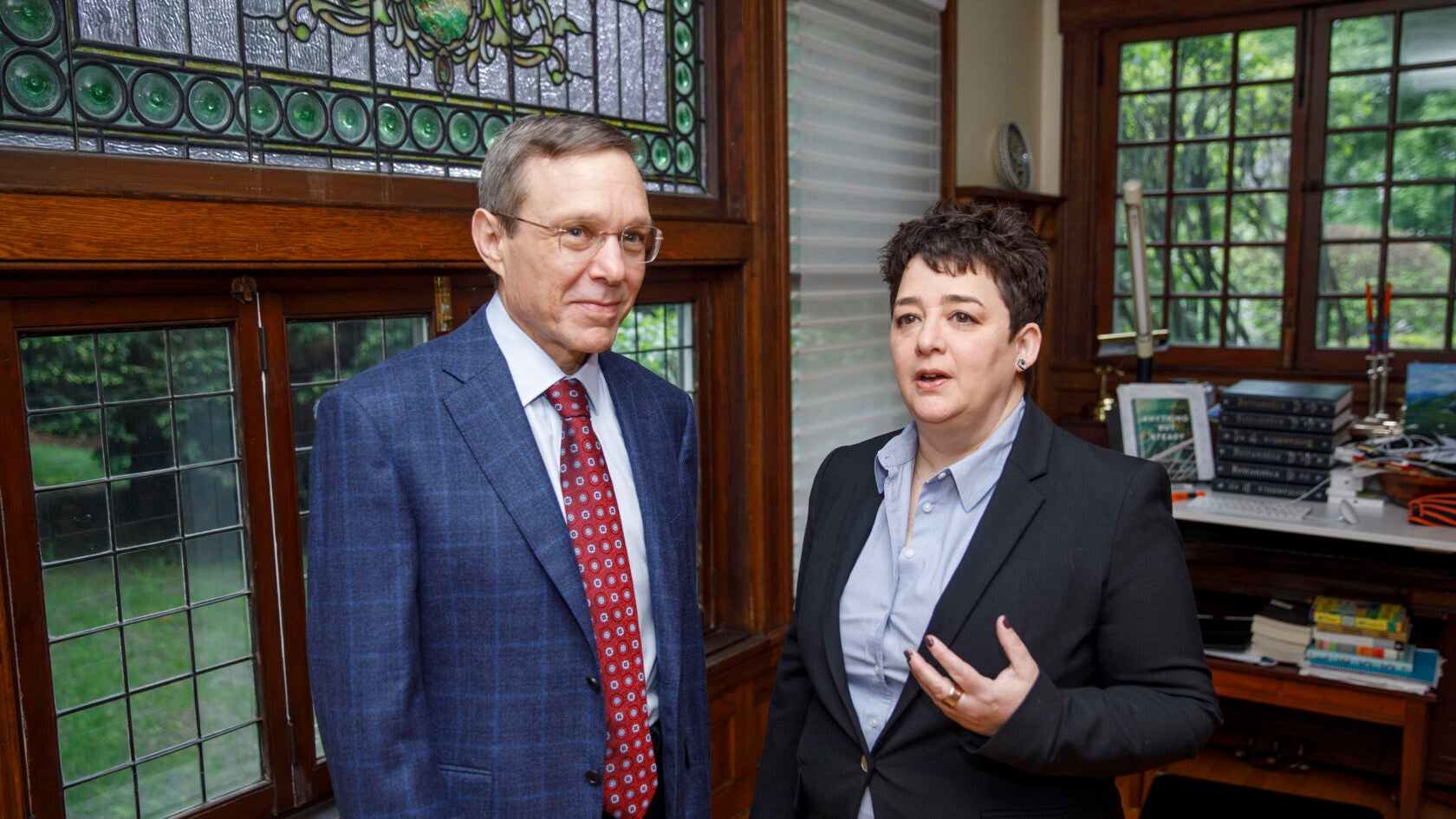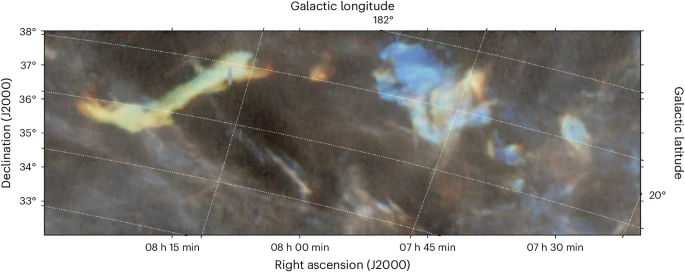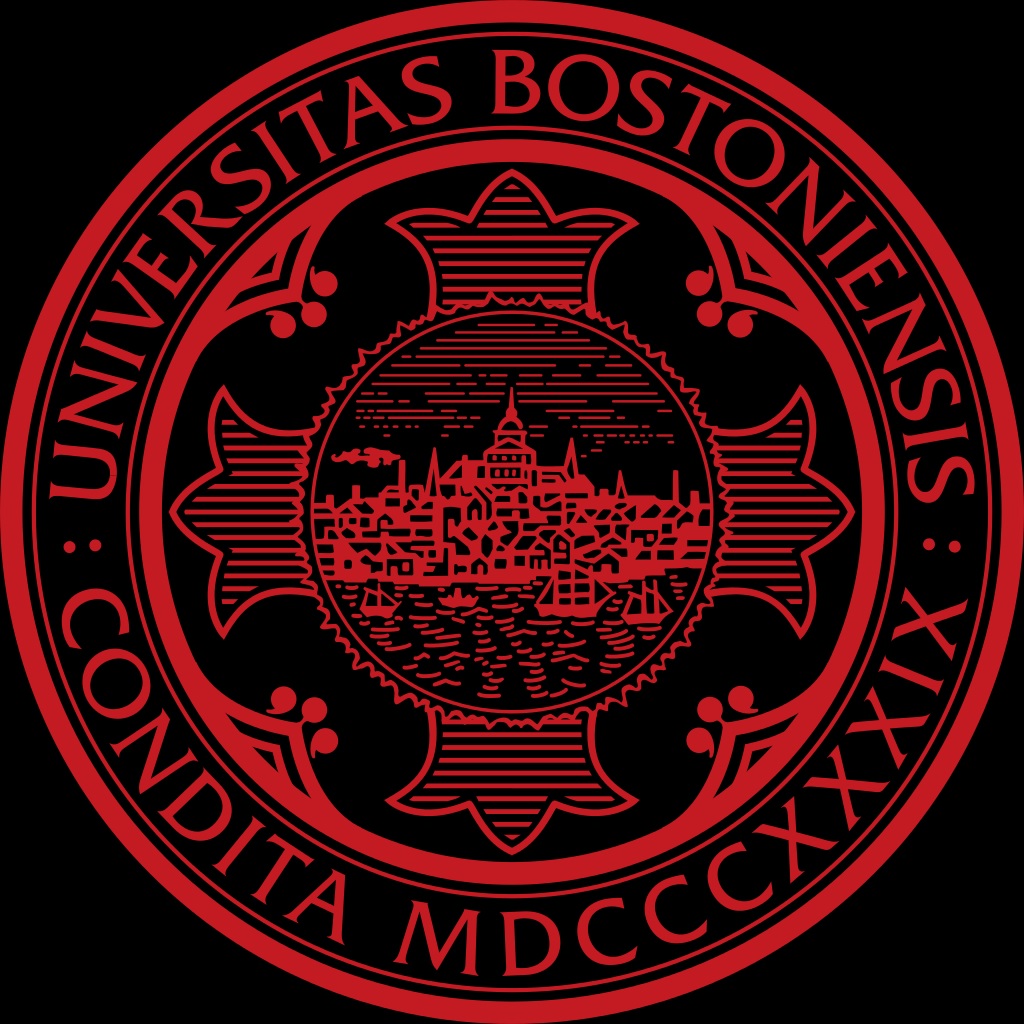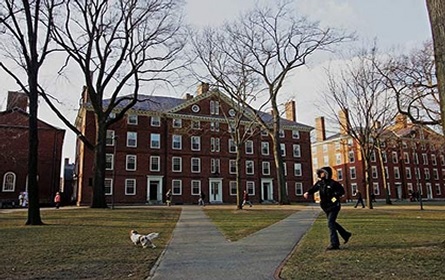At
And
6.10.24
Alvin Powell
New study finds Earth collided with dense interstellar cloud possibly affecting life on the planet.

Avi Loeb (left) and Merav Opher used computer models to track the sun’s path back to a potential collision. Kris Snibbe/Harvard Staff Photographer
Call it the Milky Way mystery.
Evidence of a long-ago collision involving the Earth was there in the form of specific radioactive isotopes deposited across the Earth and Moon. There were, however, skeptics.
But now researchers have tracked the sun’s path through the Milky Way back to a crash 2 to 3 million years ago with a dense interstellar cloud. The event was so violent it appears to have collapsed the sun’s protective bubble around the solar system and possibly even affected life on Earth.

Merav Opher, a Boston University astronomy professor and director of BU’s SHIELD NASA DRIVE Center, made the discovery in work conducted during a 2021-22 fellowship at the Radcliffe Institute for Advanced Study and published recently in Nature Astronomy.
Fig. 1: Zoom-in of the LxCCs as seen in 21 cm data from the GALFA-HI survey.

In this visualization, three 21 cm velocity channels, each 0.786 km s^−1 wide, are mapped to red, blue and green. Red represents 8 km s^−1, green 8.7 km s^−1 and blue 9.5 km s^−1, all in the local standard of rest (LSR) frame. The scale is logarithmic from 2 to 40 K brightness temperature. The visualization technique is designed to make the cold clouds stand out in colour (green and red for the left component and iridescent blue for the right component) by taking advantage of the narrowness of their velocity profiles compared to the warmer background gas much farther away. GALFA-HI survey data from ref. 67*.
*Science paper reference.
See the science paper for further instructive material with images.
Her project explored whether the Earth might have come in contact with the interstellar medium outside of the heliosphere, the protective bubble around the solar system created by the sun’s magnetic field and the solar wind.
Though the Earth is often thought of as a planet circling a stationary star, the sun is constantly in motion. In fact, it travels through the galaxy at about 56,000 miles per hour — bringing with it the planets, asteroids, comets, and other bodies of the solar system.
Researchers believe that during those travels a collision may have happened between 2 million and 3 million years ago, and another around 7 million years ago. The evidence exists in the form of noticeable peaks in the deposition of two radioactive isotopes: iron 60 and plutonium 244. Both are very rare, created when massive stars explode in supernova. Those isotopes are thought to be more plentiful in the interstellar medium.
“It is everywhere, in the deep ocean, on the moon, on ice in Antarctica,” Opher said. “These papers describe a global phenomenon. Something happened. And iron 60 is not produced on Earth. So I knew that somehow this iron 60 got trapped in dust, and somehow, 2 to 3 million years ago, we had more dust delivered to us.”
Earth Forced from the Protective Heliosphere: What Do We know?
For the interstellar medium (“ISM”) to be the source of the deposition spikes, however, something unusual must have happened, because today the ISM is nowhere near Earth.

An annotated illustration of the interstellar medium. The solar gravity lens marks the point where a conceptual spacecraft in interstellar space could use our sun as a gigantic lens, allowing zoomed-in close-ups of planets orbiting other stars.
22 December 2016
https://web.archive.org/web/20190617075031/https://www.nasa.gov/feature/jpl/interstellar-crossing-the-cosmic-void/
Charles Carter/Keck Institute for Space Studies
The heliosphere’s outer fringe — where the interstellar medium begins — is 11 billion miles away, well beyond the orbits of the outer planets [see Voyager below].
Opher started her exploration of potential Earth-ISM contact by reviewing research on the sun’s galactic neighborhood, the “nearby” space out to 65 light-years away.
She initially found mostly empty space. But when she factored in the sun’s own movement, she realized that the solar system exits its interstellar neighborhood after about 1 million years.
And, as she looked farther down the path that the sun and its planets might have taken, her gaze settled on a string of dense clouds of interstellar dust and hydrogen atoms, called the “Local Ribbon of Cold Clouds”, 2 to 3 million years away as the sun flies.
“I got so excited,” Opher said. “This will collapse the heliosphere and then the Earth is in interstellar medium, collecting more dust, and that can explain this peak that I’ve seen in iron 60.”
Opher got in touch with Avi Loeb, the Frank B. Baird Jr. Professor of Science, who directs Harvard’s Institute for Theory and Computation, where Opher spent a sabbatical year from 2017 to 2018. The two used computer models to examine the movement of both the solar system and the interstellar dust clouds themselves, which are also in motion.
They tracked the sun’s path back to a potential collision with the densest cloud in the ribbon, called the “Local Lynx of Cold Clouds”, holding more than half of the ribbon’s total mass.
“We don’t often discuss the impact of astrophysics on Earth because the astronomical timescales are very long, and the human species emerged on Earth just a few million years ago,” Loeb said. “But a few million years ago there was the potential for us to be passing through a very dense cloud. We didn’t work out the biological implications, but it’s clear that if you shrink the heliosphere to within the orbit of the Earth around the sun, we are not protected anymore. It could have significant implications for life on Earth.”
For confirmation, they turned to Joshua Peek, an astronomer at the Space Telescope Science Institute, which runs the Webb and Hubble telescopes. Peek, who had published research on the Local Ribbon of Cold Clouds, cast a dubious eye on their work.
The relative movements of the bodies involved were complex, the statistics required to understand them advanced, and, he thought, the chances were vanishingly small that the sun passed through that Lynx cloud at the same time that the isotope depositions happened on Earth.
“It’s a pretty complicated thing to study,” Peek said. “So I thought, ‘I’m just not going to pay attention to this. This is some crackpot nonsense.’”
But Opher didn’t give up. She repeatedly reached out until Peek, on a pandemic-era trip to California, found himself with time on his hands. He had tested positive for COVID and, though he felt OK, was in self-imposed quarantine, far from home and the daily demands there.
So Peek decided to take a closer look at Opher’s idea. And the more he looked, the more plausible it became.
“It’ll be so easy,” Peek described his thinking. “I’ll just do a quick analysis — in one day — prove that this is impossible, and we can all move on with our lives. But after the very quick analysis, I thought, this is actually possible. I was just flabbergasted. I wrote back and said, ‘I thought I was proving you wrong, but it turned out I proved you right.’”
Interstellar space beyond the solar system is very heterogenous, Peek and Opher said.
In some places, like just outside the heliosphere, it is nearly a vacuum, averaging just 0.1 particles per cubic centimeter. By contrast, inside the heliosphere, near Earth, there are between three and 10 particles per cubic centimeter, 30 to 100 times denser. Inside a cold cloud, according to Peek’s prior research, particle density could reach 3,000 particles per cubic centimeter.
A collision with a cloud that dense would have collapsed the heliosphere to about 0.2 astronomical units, or about one-fifth of the distance between the Earth and the sun, Opher said. That would leave the Earth outside the sun’s protective influence as the solar system traversed the cloud.
Recent measurements by Voyager 1 and 2, the only crafts to have crossed from the heliosphere into the ISM, showed that the Earth would have likely experienced a spike in galactic cosmic radiation.



It also would have experienced a rain of particles — some interstellar dust, but mainly hydrogen atoms — through the atmosphere.
The particles would likely have changed the chemistry of Earth’s atmosphere, possibly affecting cloud formation, depleting ozone in the middle atmosphere, and cooling the climate.
Though outside the scope of their study, the three authors said the impact on life on Earth might have been substantial and recommended further exploration.
“Our work should trigger more studies into this question,” Loeb said. “It draws attention to our cosmic neighborhood as having potential influence on life on Earth. We usually tend to just look at it and enjoy it, but we are actually moving through interstellar space, and there could be risks along the way.”
See the full article here .
Comments are invited and will be appreciated, especially if the reader finds any errors which I can correct.
five-ways-keep-your-child-safe-school-shootings
Please help promote STEM in your local schools.
Boston University is a private research university in Boston, Massachusetts. The university is nonsectarian but has a historical affiliation with the United Methodist Church. It was founded in 1839 by Methodists with its original campus in Newbury, Vermont, before moving to Boston in 1867.
The university now has more than 4,000 faculty members and nearly 34,000 students, and is one of Boston’s largest employers. It offers bachelor’s degrees, master’s degrees, doctorates, and medical, dental, business, and law degrees through 17 schools and colleges on three urban campuses. The main campus is situated along the Charles River in Boston’s Fenway-Kenmore and Allston neighborhoods, while the Boston University Medical Campus is located in Boston’s South End neighborhood. The Fenway campus houses the Wheelock College of Education and Human Development, formerly Wheelock College, which merged with BU in 2018.
BU is a member of the Boston Consortium for Higher Education and the Association of American Universities . It is classified among “R1: Doctoral Universities – Very High Research Activity”.
Among its alumni and current or past faculty, the university counts Nobel Laureates, Pulitzer Prize winners, Rhodes Scholars, Marshall Scholars, Academy Award winners, and Emmy and Tony Award winners. BU also has MacArthur, Fulbright, and Truman Scholars, as well as American Academy of Arts and Sciences and National Academy of Sciences members, among its past and present graduates and faculty. In 1876, BU professor Alexander Graham Bell invented the telephone in a BU lab.
The Boston University Terriers compete in the NCAA Division I. BU athletic teams compete in the Patriot League, and Hockey East conferences, and their mascot is Rhett the Boston Terrier. Boston University is well known for men’s hockey, in which it has won five national championships, most recently in 2009.
Research
The University reported over $400 million in sponsored research. Funding sources included the National Science Foundation, the National Institutes of Health, the Department of Defense, the European Commission of the European Union, the Susan G. Komen Foundation, and the federal Health Resources and Services Administration. The University’s research enterprise encompasses dozens of fields, but its primary focus currently lies in seven areas: Data Science, Engineering Biology, Global Health, Infectious Diseases, Neuroscience, Photonics, and Urban Health.
The University’s strategic plan calls for the removal of barriers between previously siloed departments, schools, and fields. The result has been an increasing emphasis by the University on interdisciplinary work and the creation of multidisciplinary centers such as the Rajen Kilachand Center for Integrated Life Sciences & Engineering, a $140 million, nine-story research facility that has brought together life scientists, engineers, and physicians from the Medical and Charles River Campuses; the Institute for Health Systems Innovation & Policy, a cross-campus initiative combining business, health law, medicine, and public policy; a neurophotonics center that combines photonics and neuroscience to study the brain; and the Software and Application Innovation Lab, where technologists work with colleagues in the arts and humanities and together develop digital research tools. The University also made a large investment in an emerging field, when it created a new university-wide academic unit called the Faculty of Computing & Data Sciences in 2019 and began construction of the nineteen-story Center for Computing & Data Sciences.
In 2003, the National Institute of Allergy and Infectious Diseases awarded Boston University a grant to build one of two National Biocontainment Laboratories. The National Emerging Infectious Diseases Laboratories (NEIDL) was created to study emerging infectious diseases that pose a significant threat to public health. NEIDL has biosafety level 2, 3, and 4 (BSL-2, BSL-3, and BSL-4, respectively) labs that enable researchers to work safely with the pathogens. BSL-4 labs are the highest level of biosafety labs and work with diseases with a high risk of aerosol transmission.
The strategic plan also encouraged research collaborations with industry and government partners. In 2016, as part of a broad-based effort to solve the critical problem of antibiotic resistance, the US Department of Health & Human Services selected the Boston University School of Law (LAW)—and Kevin Outterson, a BU professor of law—to lead a $350 million trans-Atlantic public-private partnership called CARB-X to foster the preclinical development of new antibiotics and antimicrobial rapid diagnostics and vaccines.
That same year, BU researcher Avrum Spira joined forces with Janssen Research & Development and its Disease Interception Accelerator group. Spira—a professor of medicine, pathology and laboratory medicine, and bioinformatics—has spent his career at BU pursuing a better, and earlier, way to diagnose pulmonary disorders and cancers, primarily using biomarkers and genomic testing. In 2015, under a $13.7 million Defense Department grant, Spira’s efforts to identify which members of the military will develop lung cancer and COPD caught the attention of Janssen, part Johnson & Johnson. They are investing $10.1 million to collaborate with Spira’s lab with the hope that his discoveries—and potential therapies—could then apply to the population at large.
In its effort to increase diversity and inclusion, Boston University appointed Ibram X. Kendi in July 2020 as a history professor and the director and founder of its newly established Center for Antiracist Research. The university also appointed alumna Andrea Taylor as its first senior diversity officer.
Although Harvard Astronomy came into existence in 1931, the first chair, Donald Menzel, wasn’t appointed until 1945. Menzel was subsequently named Director of the Harvard Observatory in 1952 and immediately set about to encourage the Smithsonian Astrophysical Observatory to relocate to Cambridge, which it did in 1955.
Fred Whipple was appointed as Professor of Astronomy in 1950 and was the department’s second chair. In 1955 he assumed directorship of the SAO in its new location. In 1956 Cecilia Payne-Gaposchkin became the first woman to be promoted to full professor from within the Faculty of Arts and Sciences and soon after was appointed the third chair, making her the first woman to head a department at Harvard University.
George Field formalized the interactions between the two organizations by creating an administrative umbrella organization named The Harvard-Smithsonian Center for Astrophysics. The Department of Astronomy, under a Chair, continues as an autonomous unit under the direction of the Harvard University Faculty of Arts of Sciences but is housed at the CfA.
The complement of approximately 60 PhD students, 25 undergraduate students and over 100 post-doctoral researchers enjoy access to the remarkable resources provided by both Harvard and Smithsonian faculties and facilities.
Harvard University is the oldest institution of higher education in the United States, established in 1636 by vote of the Great and General Court of the Massachusetts Bay Colony. It was named after the College’s first benefactor, the young minister John Harvard of Charlestown, who upon his death in 1638 left his library and half his estate to the institution. A statue of John Harvard stands today in front of University Hall in Harvard Yard, and is perhaps the University’s bestknown landmark.
Harvard University has 12 degree-granting Schools in addition to the Radcliffe Institute for Advanced Study. The University has grown from nine students with a single master to an enrollment of more than 20,000 degree candidates including undergraduate, graduate, and professional students. There are more than 360,000 living alumni in the U.S. and over 190 other countries.
The Massachusetts colonial legislature, the General Court, authorized Harvard University’s founding. In its early years, Harvard College primarily trained Congregational and Unitarian clergy, although it has never been formally affiliated with any denomination. Its curriculum and student body were gradually secularized during the 18th century, and by the 19th century, Harvard University (US) had emerged as the central cultural establishment among the Boston elite. Following the American Civil War, President Charles William Eliot’s long tenure (1869–1909) transformed the college and affiliated professional schools into a modern research university; Harvard became a founding member of the Association of American Universities in 1900. James B. Conant led the university through the Great Depression and World War II; he liberalized admissions after the war.
The university is composed of ten academic faculties plus the Radcliffe Institute for Advanced Study. Arts and Sciences offers study in a wide range of academic disciplines for undergraduates and for graduates, while the other faculties offer only graduate degrees, mostly professional. Harvard has three main campuses: the 209-acre (85 ha) Cambridge campus centered on Harvard Yard; an adjoining campus immediately across the Charles River in the Allston neighborhood of Boston; and the medical campus in Boston’s Longwood Medical Area. Harvard University’s endowment is valued at $41.9 billion, making it the largest of any academic institution. Endowment income helps enable the undergraduate college to admit students regardless of financial need and provide generous financial aid with no loans The Harvard Library is the world’s largest academic library system, comprising 79 individual libraries holding about 20.4 million items.
Harvard University has more alumni, faculty, and researchers who have won Nobel Prizes (161) and Fields Medals (18) than any other university in the world and more alumni who have been members of the U.S. Congress, MacArthur Fellows, Rhodes Scholars (375), and Marshall Scholars (255) than any other university in the United States. Its alumni also include eight U.S. presidents and 188 living billionaires, the most of any university. Fourteen Turing Award laureates have been Harvard affiliates. Students and alumni have also won 10 Academy Awards, 48 Pulitzer Prizes, and 108 Olympic medals (46 gold), and they have founded many notable companies.
Colonial
Harvard University was established in 1636 by vote of the Great and General Court of the Massachusetts Bay Colony. In 1638, it acquired British North America’s first known printing press. In 1639, it was named Harvard College after deceased clergyman John Harvard, an alumnus of the University of Cambridge (UK) who had left the school £779 and his library of some 400 volumes. The charter creating the Harvard Corporation was granted in 1650.
A 1643 publication gave the school’s purpose as “to advance learning and perpetuate it to posterity, dreading to leave an illiterate ministry to the churches when our present ministers shall lie in the dust.” It trained many Puritan ministers in its early years and offered a classic curriculum based on the English university model—many leaders in the colony had attended the University of Cambridge—but conformed to the tenets of Puritanism. Harvard University has never affiliated with any particular denomination, though many of its earliest graduates went on to become clergymen in Congregational and Unitarian churches.
Increase Mather served as president from 1681 to 1701. In 1708, John Leverett became the first president who was not also a clergyman, marking a turning of the college away from Puritanism and toward intellectual independence.
19th century
In the 19th century, Enlightenment ideas of reason and free will were widespread among Congregational ministers, putting those ministers and their congregations in tension with more traditionalist, Calvinist parties. When Hollis Professor of Divinity David Tappan died in 1803 and President Joseph Willard died a year later, a struggle broke out over their replacements. Henry Ware was elected to the Hollis chair in 1805, and the liberal Samuel Webber was appointed to the presidency two years later, signaling the shift from the dominance of traditional ideas at Harvard to the dominance of liberal, Arminian ideas.
Charles William Eliot, president 1869–1909, eliminated the favored position of Christianity from the curriculum while opening it to student self-direction. Though Eliot was the crucial figure in the secularization of American higher education, he was motivated not by a desire to secularize education but by Transcendentalist Unitarian convictions influenced by William Ellery Channing and Ralph Waldo Emerson.
20th century
In the 20th century, Harvard University’s reputation grew as a burgeoning endowment and prominent professors expanded the university’s scope. Rapid enrollment growth continued as new graduate schools were begun and the undergraduate college expanded. Radcliffe College, established in 1879 as the female counterpart of Harvard College, became one of the most prominent schools for women in the United States. Harvard University (US) became a founding member of the Association of American Universities in 1900.
The student body in the early decades of the century was predominantly “old-stock, high-status Protestants, especially Episcopalians, Congregationalists, and Presbyterians.” A 1923 proposal by President A. Lawrence Lowell that Jews be limited to 15% of undergraduates was rejected, but Lowell did ban blacks from freshman dormitories.
President James B. Conant reinvigorated creative scholarship to guarantee Harvard University’s preeminence among research institutions. He saw higher education as a vehicle of opportunity for the talented rather than an entitlement for the wealthy, so Conant devised programs to identify, recruit, and support talented youth. In 1943, he asked the faculty to make a definitive statement about what general education ought to be, at the secondary as well as at the college level. The resulting Report, published in 1945, was one of the most influential manifestos in 20th century American education.
Between 1945 and 1960, admissions were opened up to bring in a more diverse group of students. No longer drawing mostly from select New England prep schools, the undergraduate college became accessible to striving middle class students from public schools; many more Jews and Catholics were admitted, but few blacks, Hispanics, or Asians. Throughout the rest of the 20th century, Harvard became more diverse.
Harvard University’s graduate schools began admitting women in small numbers in the late 19th century. During World War II, students at Radcliffe College (which since 1879 had been paying Harvard University professors to repeat their lectures for women) began attending Harvard University classes alongside men. Women were first admitted to the medical school in 1945. Since 1971, Harvard University has controlled essentially all aspects of undergraduate admission, instruction, and housing for Radcliffe women. In 1999, Radcliffe was formally merged into Harvard University.
21st century
Drew Gilpin Faust, previously the dean of the Radcliffe Institute for Advanced Study, became Harvard University’s first woman president on July 1, 2007. She was succeeded by Lawrence Bacow on July 1, 2018.







